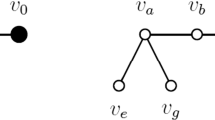Abstract
A walk with no arc repeated which begins and ends with forward arcs, in which the arcs alternate between forward and backward arcs, is called forward antidirected trail. A digraph D with order at least three containing a forward antidirected (x, y)-trail for every pair of distinct vertices x, y of D is antistrong. In this paper, we show that the Cartesian product of two antistrong digraphs is antistrong. Moreover, one of the results is that the Lexicographic product of an antistrong digraph and a digraph is antistrong. Finally, the subject is researched to give a necessary and sufficient condition to decide whether a tournament is antistrong.



Similar content being viewed by others
References
Bang-Jensen, J., Gutin, G.: Digraphs: Theory, Algorithms and Applications, 2nd edn. Springer Verlag, London (2009)
Chartrand, G., Gavlas, H., Schultz, M., Wall, C.E.: Anticonnected digraphs. Util. Math. 51, 41–54 (1997)
Grünbaum, B.: Antidirected Hamiltonian paths in tournaments. J. Combin. Theory Ser. B 11, 249–257 (1971)
Bang-Jensen, J., Bessy, S., Jackson, B., Kriesell, M.: Antistrong digraphs. J. Combin. Theory Ser. B 122, 68–90 (2017)
Klavžar, S.: Coloring graph products–a survey. Discrete Math. 155, 135–145 (1996)
Stadler, B.M.R., Stadler, P.F.: The topology of evolutionary biology. In: Modelling in Molecular Biology, Springer, pp. 267–286 (2004)
Wagner, G., Stadler, P.F.: Quasi-independence, homology and the unity of type: a topological theory of characters. J. Theoret. Biol. 220, 505–527 (2003)
Archambault, D., Munzner, T., Auber, D.: TopoLayout: multilevel graph layout by topological features. IEEE Trans. Vis. Comput. Graph. 13(2), 305–317 (2007)
Jänicke, S., Heine, C., Hellmuth, M., Stadler, P., Scheuermann, G.: Visualization of graph products. IEEE Trans. Vis. Comput. Graph. 16(6), 1082–1089 (2010)
Kaveh, A.: Optimal Analysis of Structures by Concepts of Symmetry and Regularity. Springer, Berlin (2013)
Kaveh, A., Koohestani, K.: Graph products for configuration processing of space structures. Comput. Struct. 86(11–12), 1219–1231 (2008)
Kaveh, A., Rahami, H.: An efficient method for decomposition of regular structures using graph products. Internat J. Numer. Methods Eng. 61(11), 1797–1808 (2004)
Hammack, R., Imrich, W., Klavžar, S.: Handbook of Product Graphs, 2nd edn. CRC Press, Boca Roton (2011)
Imrich, W., Klavžar, S.: Product Graphs. Wiley-Intersci. Ser. Discrete Math. Optim. Wiley-Interscience, New York (2000)
Chiue, W.S., Shieh, B.S.: On connectivity of the cartesian product of two graphs. Appl. Math. Comput. 102, 129–137 (1999)
Špacapan, S.: Connectivity of Cartesian products of graphs. Appl. Math. Lett. 21, 682–685 (2008)
Györi, E., Plummer, M.: The cartesian product of a \(k\)-extendable and an \(l\)-extendable graph is \((k + l + 1)\)-extendable. Discrete Math. 101, 87–96 (1992)
Acknowledgements
The authors would like to express their gratitude to the editor and anonymous reviewers for their valuable comments and constructive suggestions on the original manuscript. This research is supported by the Natural Science Foundation of Xinjiang Province, China (Nos. 2020D04046, 2021D01C116).
Author information
Authors and Affiliations
Corresponding author
Ethics declarations
Conflict of Interest
The authors declare that they have no known competing financial interests or personal relationships that could have appeared to influence the work reported in this paper.
Additional information
Publisher's Note
Springer Nature remains neutral with regard to jurisdictional claims in published maps and institutional affiliations.
The research is supported by NSFXJ (No. 2020D04046, 2021D01C116)
Rights and permissions
About this article
Cite this article
Yuan, L., Meng, J. & Sabir, E. The Antistrong Property for Special Digraph Families. Graphs and Combinatorics 37, 2511–2519 (2021). https://doi.org/10.1007/s00373-021-02375-w
Received:
Revised:
Accepted:
Published:
Issue Date:
DOI: https://doi.org/10.1007/s00373-021-02375-w




